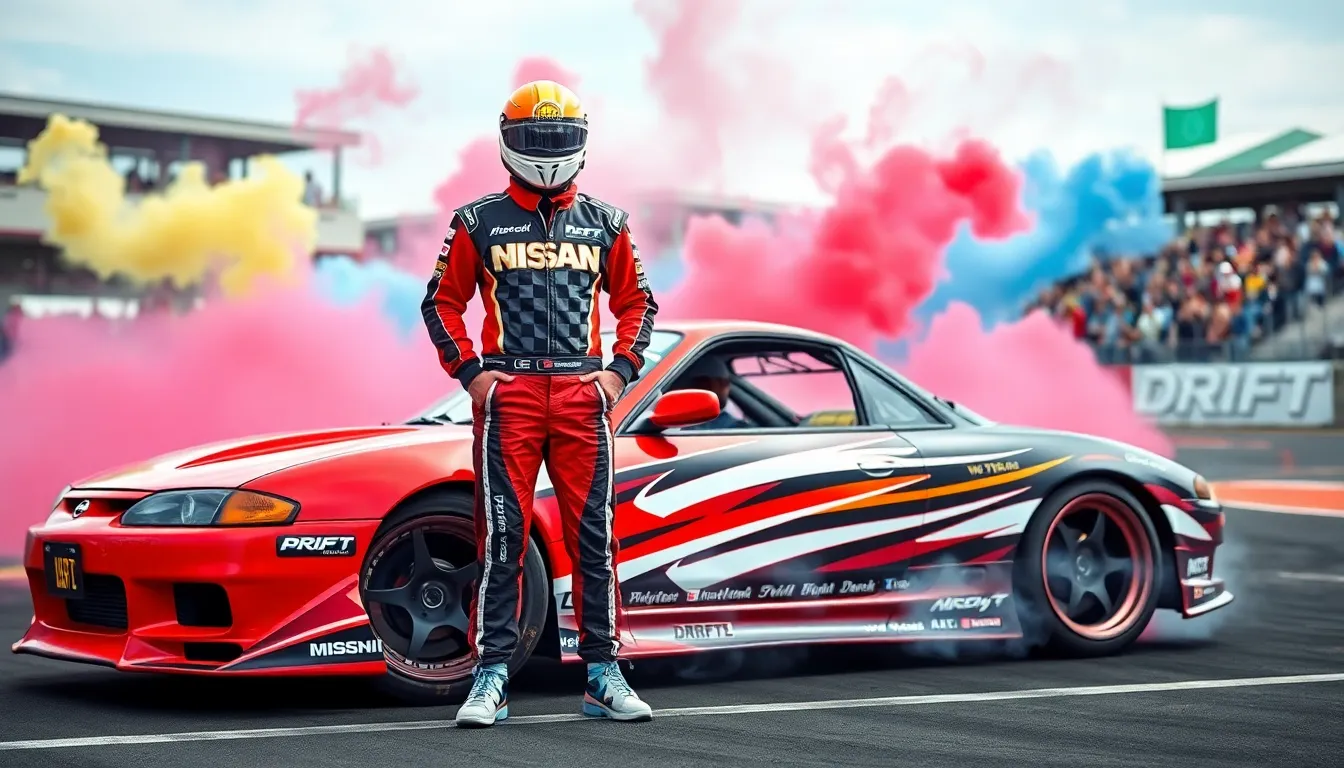Drift cars represent the ultimate fusion of precision engineering and controlled chaos on the track. These specially modified vehicles transform the art of losing traction into a mesmerizing display of skill and automotive prowess that’s captivated motorsport enthusiasts worldwide.
We’ve witnessed drift culture evolve from underground Japanese street racing to a global phenomenon that’s redefined what it means to push a car beyond its limits. Unlike traditional racing where speed matters most, drifting demands a unique combination of throttle control, steering precision, and split-second decision-making that separates true artists from casual drivers.
From modified Nissan Silvias to purpose-built Formula Drift machines pumping out over 1,000 horsepower, drift cars showcase incredible diversity in builds and approaches. Whether you’re curious about getting into the sport or simply fascinated by these sideways-sliding machines, understanding what makes a proper drift car will open your eyes to one of motorsport’s most thrilling disciplines.
What Makes a Car Perfect for Drifting
Understanding the technical foundations that make certain vehicles excel at drifting helps us appreciate why exact car characteristics dominate drift competitions worldwide.
Rear-Wheel Drive Configuration
Rear-wheel drive systems provide the essential power delivery method that enables controlled oversteer in drift cars. Power flows directly to the rear wheels, allowing drivers to break traction by applying throttle while steering into corners. This configuration creates the fundamental physics required for sustained sideways motion.
Front-wheel drive vehicles struggle with drifting because they pull rather than push through corners. We see limited drift potential in FWD cars since the driving wheels also handle steering responsibilities. All-wheel drive systems can work for drifting but require more complex techniques and often need modifications to favor rear power distribution.
Professional drift cars overwhelmingly use RWD platforms because they offer predictable and controllable slide characteristics. Popular choices include the Nissan 240SX, Toyota AE86, and BMW 3 Series, all featuring rear-wheel drive from the factory.
Balanced Weight Distribution
Optimal weight distribution between front and rear axles creates stable and predictable drift behavior. Cars with 50/50 or close to 50/50 weight balance transition smoothly between grip and drift states. This balance prevents excessive understeer or snap oversteer that makes cars difficult to control.
Front-heavy vehicles require more driver input and skill to maintain consistent drift angles. We observe that cars with 60/40 or worse front weight bias tend to push through corners rather than rotate naturally. Rear-heavy cars can be twitchy and unpredictable, especially for novice drifters.
Many successful drift cars feature naturally balanced designs or benefit from weight reduction modifications. The Toyota AE86 earned its legendary status partly due to its near-perfect 53/47 weight distribution. Modern drift builds often relocate batteries, remove unnecessary components, and add strategic ballast to achieve ideal balance.
Manual Transmission Advantages
Manual transmissions offer precise control over power delivery and engine braking that automatic systems cannot match. Clutch control allows drivers to modulate power transfer during transitions and maintain optimal engine RPM for consistent power output. This direct connection between driver input and drivetrain response proves crucial for competition-level drifting.
Heel-toe downshifting techniques become possible only with manual gearboxes, enabling smooth corner entry while maintaining drift momentum. We use clutch kicks to initiate oversteer by suddenly captivating the clutch to break rear tire traction. These techniques require the mechanical connection that manual transmissions provide.
Automatic transmissions limit drift performance through delayed throttle response and reduced engine braking capability. Modern automatics with manual modes improve the situation but still lack the instantaneous response that serious drifting demands. Sequential manual transmissions represent the ultimate choice for professional drift cars, offering lightning-fast shifts without interrupting power flow.
Top Japanese Drift Cars That Started It All
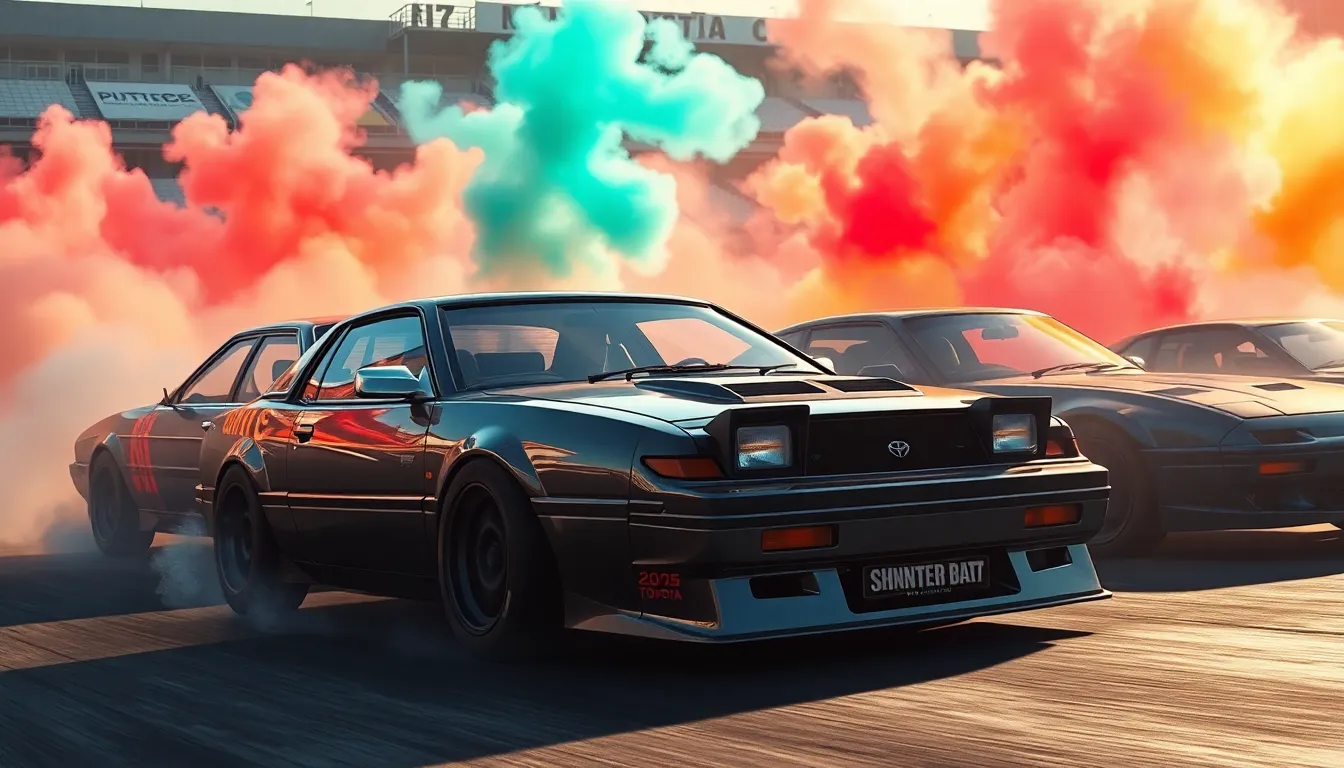
Japanese engineers created the foundation of modern drift culture through innovative design and engineering excellence. These legendary machines transformed street racing into an art form that continues to influence motorsports worldwide.
Nissan 240SX (S13, S14, S15)
Nissan’s 240SX platform revolutionized drift culture with its perfect balance of affordability and performance capabilities. We’ve witnessed countless drivers cut their teeth on these rear wheel drive legends since the late 1980s.
Performance specifications make the 240SX an ideal drift platform across all generations:
| Model | Years | Engine | Weight | Power |
|---|---|---|---|---|
| S13 | 1989-1994 | SR20DET | 2,700 lbs | 205 hp |
| S14 | 1995-1998 | SR20DET | 2,800 lbs | 220 hp |
| S15 | 1999-2002 | SR20DET | 2,900 lbs | 250 hp |
Engineering excellence shines through the 240SX’s near perfect 53/47 weight distribution. Aftermarket support for these chassis remains unmatched with companies like Wisefab and SPL Parts offering comprehensive suspension packages. Turbocharged SR20DET engines respond exceptionally well to modifications like larger turbochargers and fuel system upgrades.
Toyota AE86 Corolla
Toyota’s AE86 Corolla earned legendary status as the ultimate beginner drift car through its lightweight chassis and predictable handling characteristics. We consider this rear wheel drive compact the purest expression of drift fundamentals.
Specifications that made the AE86 a drift icon include its 2,400 pound curb weight and naturally aspirated 4A-GE twin cam engine producing 112 horsepower. Weight distribution sits at an ideal 53/47 front to rear ratio while the MacPherson strut front and four link rear suspension provide excellent feedback.
Accessibility remains the AE86’s greatest strength as novice drifters can learn proper technique without overwhelming power levels. Professional drivers like Keiichi Tsuchiya used these Corollas to develop fundamental drift skills before moving to higher powered machines. Modern examples command premium prices due to their cult following and diminishing supply.
Mazda RX-7 and RX-8
Mazda’s rotary powered sports cars brought unique characteristics to drift culture through their distinctive Wankel engines and exceptional chassis dynamics. We’ve observed how these machines offer a completely different driving experience compared to piston engine competitors.
Rotary engine advantages include incredibly smooth power delivery and compact dimensions that allow for optimal weight distribution:
| Model | Engine | Weight Distribution | Power Output |
|---|---|---|---|
| FC RX-7 | 13B Twin Turbo | 50/50 | 200-280 hp |
| FD RX-7 | 13B-REW Twin Turbo | 50/50 | 255-280 hp |
| RX-8 | 13B-MSP Renesis | 50/50 | 232-238 hp |
Sequential twin turbo systems in the FD RX-7 provide incredible top end power while maintaining smooth boost delivery throughout the rev range. Perfect 50/50 weight distribution across all models creates predictable drift behavior that rewards precise throttle control. High revving nature of rotary engines allows drivers to maintain consistent power output during extended drift sequences.
Reliability concerns require dedicated maintenance schedules including regular apex seal inspections and proper engine warming procedures. Enthusiasts often rebuild rotary engines with upgraded internals from companies like Racing Beat and Mazdatrix to handle increased boost levels.
American Muscle Cars Perfect for Drift Racing
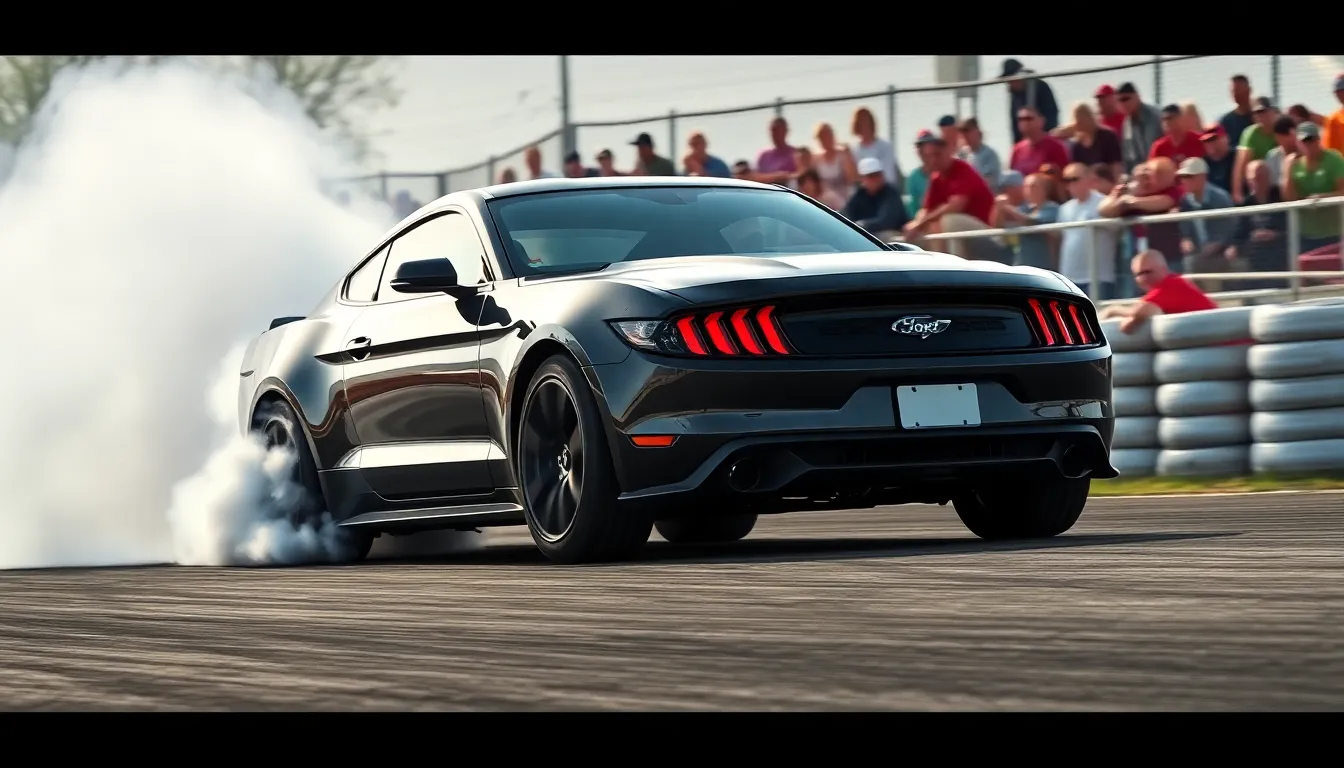
While Japanese cars pioneered drift culture, American muscle cars have evolved into formidable drift machines with their naturally rear-wheel drive layouts and abundant power. These iconic vehicles bring raw horsepower and distinctive character to the drift scene.
Ford Mustang Drift Builds
S550 generation Mustangs dominate modern drift competitions with their independent rear suspension and precise handling characteristics. Professional drifters like Chelsea DeNofa and Vaughn Gittin Jr. have proven these platforms can compete at the highest levels of Formula Drift.
Performance modifications typically start with suspension upgrades including coilovers, adjustable control arms, and limited slip differentials. Engine builds range from naturally aspirated Coyote V8s producing 500+ horsepower to supercharged setups exceeding 700 horsepower.
Weight distribution improvements involve relocating the battery to the trunk and adding strategic ballast to achieve optimal balance. Popular tire combinations include 265/35R18 rear tires for controlled breakaway and improved smoke production.
Budget builds using older Fox body and SN95 Mustangs offer affordable entry points into muscle car drifting. These platforms benefit from their lighter weight and simpler suspension geometries that respond well to basic modifications.
Chevrolet Camaro Modifications
Fifth and sixth generation Camaros provide excellent drift foundations with their sophisticated chassis engineering and powerful LS and LT engines. Factory options like magnetic ride control and electronic limited slip differentials enhance drift performance straight from the showroom.
Engine swaps remain popular with older F-body Camaros, where modern LS engines replace original small blocks for improved reliability and power output. Common builds feature LS3 or LS7 engines producing 450 to 550 horsepower.
Suspension tuning focuses on reducing understeer through front spring rate increases and rear anti-roll bar adjustments. Drift exact alignments typically use aggressive front camber settings and reduced rear toe for improved slide initiation.
Aerodynamic packages help balance these front heavy cars during sustained drifts. Functional rear wings and front splitters manage airflow while aggressive body kits accommodate wider wheel and tire combinations.
Dodge Challenger Drift Setups
SRT Hellcat Challengers bring supercharged 707+ horsepower to drift competitions, requiring important chassis modifications to handle the extreme power output. Professional builds often feature roll cages, fuel cells, and comprehensive safety equipment.
Weight reduction becomes critical with these heavy muscle cars, involving interior stripping, carbon fiber body panels, and lightweight wheel selections. Target weights typically range from 3,800 to 4,200 pounds depending on safety equipment requirements.
Transmission upgrades include heavy duty clutches, reinforced driveshafts, and upgraded rear differentials to handle increased torque loads. Manual transmission swaps remain popular for drivers seeking maximum control over power delivery.
Cooling system modifications prevent overheating during extended drift sessions through upgraded radiators, oil coolers, and improved airflow management. Brake cooling ducts become essential for managing the thermal loads from aggressive driving.
European Drift Cars Gaining Popularity
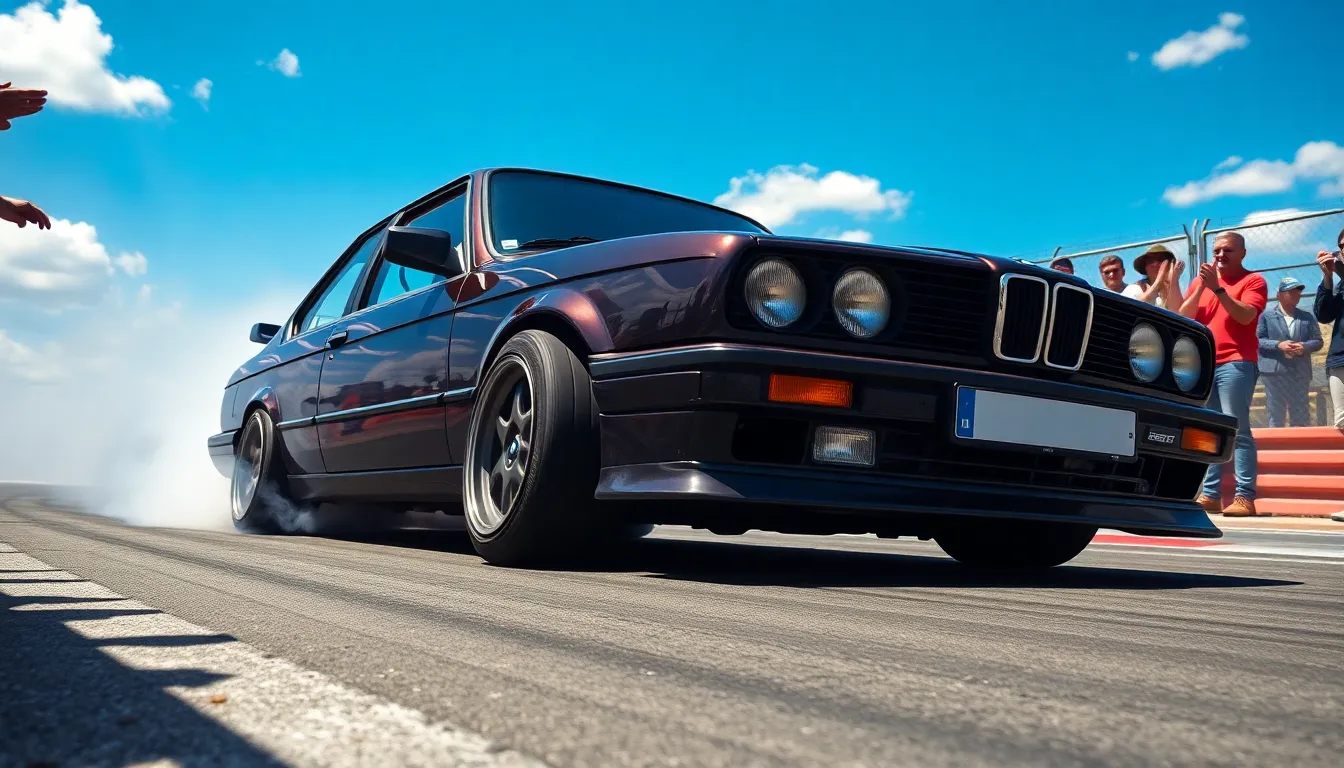
European manufacturers have carved out a important niche in the global drift scene, offering unique alternatives to Japanese and American platforms. These vehicles bring distinct engineering philosophies and characteristics that appeal to drifters seeking different driving experiences.
BMW E30 and E36 Models
BMW’s E30 and E36 chassis have become cornerstones of European drift culture. The E30 3 Series (1982-1994) delivers exceptional balance with its near-perfect 50/50 weight distribution and responsive rear-wheel drive setup. Professional drifters praise the E30’s predictable handling characteristics and robust M20 and M50 engines that provide reliable power delivery.
E36 models (1990-2000) offer more modern amenities while maintaining the drift-friendly fundamentals that made their predecessors famous. These platforms feature improved chassis rigidity and more powerful engine options including the legendary S52 and S50 units. Common modifications include coilover suspension systems, limited-slip differentials, and angle kits to increase steering lock for competitive drifting.
Budget builds often start with 325i or 328i models due to their availability and aftermarket support. Engine swaps using LS series V8s or BMW’s own S54 powerplants have gained popularity for serious competition builds. Weight reduction through interior stripping and carbon fiber components helps optimize the power-to-weight ratio for enhanced drift performance.
Mercedes-Benz W124 Drift Builds
Mercedes-Benz W124 chassis (1984-1997) represents an unconventional but increasingly popular drift platform. These vehicles offer solid build quality and surprising drift potential when properly modified. The 300E and 400E models provide strong engine foundations for drift builds with their robust inline-six and V8 powerplants respectively.
Suspension modifications form the backbone of W124 drift conversions with custom coilover setups and adjustable control arms. Limited-slip differential installations dramatically improve traction control during drift maneuvers. Weight distribution sits slightly forward biased compared to purpose-built drift cars but responds well to strategic weight reduction and ballast placement.
Professional drifters have demonstrated the W124’s capabilities in competition settings with extensive modifications. Engine swaps using modern Mercedes AMG powerplants or aftermarket turbo systems can produce substantial power increases. The platform’s unique aesthetic and unexpected nature make it a standout choice for drifters seeking something different from traditional Japanese imports.
Volvo 240 Drift Projects
Volvo 240 models (1974-1993) have emerged as surprising drift contenders even though their reputation as family sedans. These vehicles offer excellent chassis rigidity and rear-wheel drive configuration that translates well to drift applications. The turbocharged variants provide strong torque characteristics ideal for maintaining tire slip angles during extended drift sequences.
Weight distribution requires attention in 240 drift builds due to the front-heavy nature of these vehicles. Strategic weight reduction through interior removal and lightweight components helps achieve better balance. Engine modifications often focus on turbocharger upgrades and fuel system enhancements to support increased power levels safely.
Swedish and European drift scenes have embraced the 240 platform for its durability and unique character. Common builds feature B230FT engines with upgraded turbochargers producing 300-400 horsepower reliably. Suspension modifications include adjustable coilover systems and reinforced subframes to handle the increased stress of competitive drifting. The platform’s unconventional nature and robust construction make it an intriguing alternative for drifters exploring beyond traditional choices.
Essential Modifications for Building Drift Cars
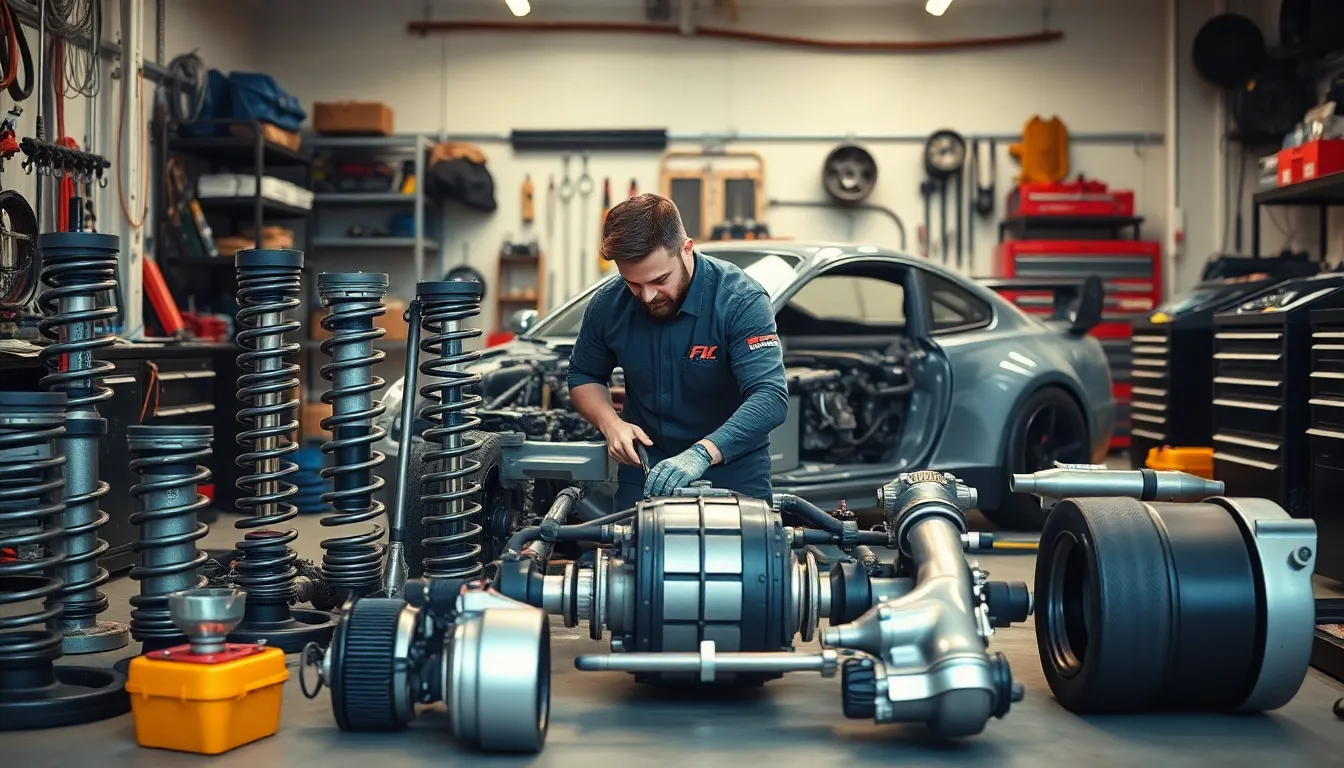
Building a competitive drift car requires strategic upgrades that transform standard vehicles into sideways machines. We’ll explore the core modifications that unlock a car’s drift potential and enhance control during sustained slides.
Suspension and Coilover Systems
Coilovers serve as the foundation for any serious drift build, providing adjustable height, damping, and spring rates. We recommend systems with separate compression and rebound adjustments, allowing fine-tuning for different track conditions. Popular choices include BC Racing BR series, Tein Flex Z, and HKS Hipermax coilovers that offer professional-grade adjustability.
Angle kits increase front steering lock beyond factory limitations, enabling tighter drift lines and better chase runs. We typically see angle modifications providing 60-80 degrees of lock compared to the standard 35-40 degrees. Companies like SPL Parts, Wisefab, and SLR produce comprehensive angle kits for popular drift platforms.
Roll bars and chassis stiffening prevent excessive body roll during transitions while maintaining predictable handling characteristics. We suggest adjustable front and rear anti-roll bars that allow tuning for different driving styles. Whiteline, Hotchkis, and Eibach manufacture quality stabilizer bars that complement coilover setups.
Bushings and suspension components benefit from polyurethane or spherical bearing upgrades that eliminate unwanted flex. We replace rubber bushings with harder compounds that provide consistent geometry under load. Energy Suspension and Prothane offer complete bushing kits that dramatically improve suspension response.
Limited Slip Differential Upgrades
Mechanical differentials provide the consistent lockup characteristics essential for maintaining drift angles. We prefer 1.5-way or 2-way limited slip differentials that engage during both acceleration and deceleration. Kaaz, OS Giken, and Cusco manufacture reliable mechanical LSDs that handle high torque applications.
Clutch type differentials offer adjustable preload and lockup rates through different clutch pack configurations. We recommend starting with moderate lockup percentages around 60-80% and adjusting based on driving style. These units require regular maintenance but provide excellent performance and longevity.
Welded differentials represent the budget-friendly option for grassroots drifting, creating a solid axle effect. We acknowledge that welded diffs can be harsh on drivetrains and challenging to drive on the street. But, they’re nearly indestructible and provide maximum traction for learning drift techniques.
Installation considerations include upgraded axles, differential coolers, and proper gear oil selection. We suggest synthetic 75W-90 gear oil with friction modifiers for mechanical LSDs. Royal Purple Max Gear and Motul Gear 300 are proven choices that maintain consistent performance under extreme conditions.
Engine and Turbo Modifications
Turbocharger upgrades transform naturally aspirated engines into drift powerhouses while maintaining responsive throttle characteristics. We recommend ball bearing turbos like the Garrett GT2860RS or Precision 5558 that provide quick spool and reliable boost delivery. Proper sizing ensures adequate power without overwhelming the chassis dynamics.
Engine internals require strengthening to handle increased boost levels and sustained high RPM operation. We upgrade pistons, connecting rods, and head studs using proven manufacturers like CP Pistons, Manley Performance, and ARP fasteners. These modifications enable safe operation at 400-600 horsepower levels common in competitive drifting.
Fuel system modifications support increased power demands through larger injectors, high-flow fuel pumps, and upgraded fuel rails. We install 1000cc+ injectors from companies like Injector Dynamics or DeatschWerks paired with Walbro or AEM high-pressure fuel pumps. E85 ethanol fuel provides additional cooling and knock resistance for turbo applications.
Cooling systems prevent overheating during extended drift sessions through upgraded radiators, oil coolers, and intercoolers. We recommend aluminum radiators from Mishimoto or CSF with dual electric fans for consistent temperature control. Proper heat management ensures reliable performance during competition events and practice sessions.
Budget-Friendly Drift Cars for Beginners
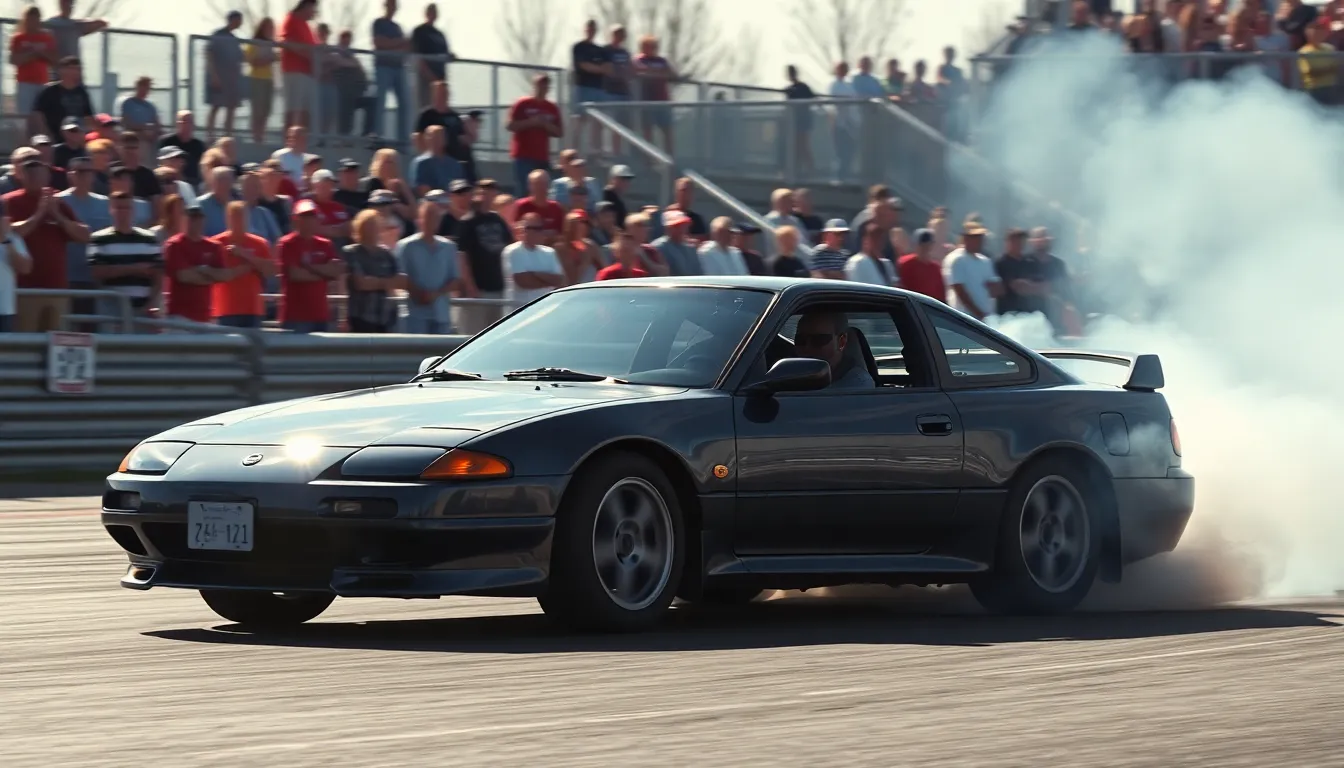
Starting your drift journey doesn’t require very costly. We’ll explore practical options that deliver authentic drift experiences while respecting tight budgets.
Affordable Platform Options
Nissan 240SX (S13/S14) remains our top recommendation for beginners seeking maximum value. These chassis offer exceptional drift potential with prices ranging from $3,000 to $8,000 depending on condition. S13 models (1989-1994) typically cost less than S14 variants, making them ideal starter platforms. We find their naturally aspirated SR20DE engines provide adequate power for learning proper technique.
Toyota AE86 Corolla continues attracting new drifters even though rising prices. Budget examples start around $4,000 for higher mileage specimens. These lightweight machines teach fundamental drift skills without overwhelming novice drivers. We recommend prioritizing rust free examples over low mileage vehicles since structural integrity matters more than cosmetic perfection.
BMW E30 3 Series presents European alternatives starting at $2,500 for project cars. Manual transmission models with rear wheel drive configuration suit drift applications perfectly. We’ve observed 325i variants offering the best power to weight ratio for entry level builds. Most examples require maintenance attention but reward owners with excellent handling characteristics.
Lexus SC300/400 delivers surprising drift potential at affordable prices. These platforms start around $3,500 for decent examples with manual transmissions. We appreciate their robust construction and available aftermarket support. The 1UZ V8 in SC400 models provides smooth power delivery ideal for learning throttle control.
Cost-Effective Modification Strategies
Suspension modifications should prioritize function over expensive brands. Coilover systems from BC Racing or Tein offer adjustability starting at $800. We recommend beginning with basic height adjustable units before investing in advanced damping controls. Welded differentials cost under $200 including labor and provide adequate traction for beginners.
Safety equipment takes priority over performance modifications in our experience. Roll cages from local fabricators cost $1,200 to $2,000 installed. We suggest starting with basic four point designs before upgrading to more complex structures. Racing seats and harnesses represent essential investments around $400 for quality options.
Engine modifications should focus on reliability rather than peak power initially. Cold air intakes and exhaust systems provide modest gains for $300 to $600 combined. We find basic engine management improvements deliver better results than expensive turbo kits for learning drivers. Regular maintenance intervals become crucial as modified engines face increased stress.
Wheel and tire combinations significantly impact drift performance without massive expense. Used wheels from racing forums cost $400 to $800 for complete sets. We recommend 17 inch diameters for optimal tire availability and cost effectiveness. Budget drift tires like Federal 595SS provide adequate grip levels at $100 per tire.
Used Car Market Considerations
Inspection priorities focus on structural integrity over cosmetic condition. We examine suspension mounting points for rust or damage that could compromise safety. Frame rails and floor pans require thorough evaluation since drift cars experience important stress. Engine compression tests reveal internal condition better than external appearance.
Documentation importance becomes critical when evaluating modified examples. Previous owners who maintained service records typically indicate responsible ownership. We prefer vehicles with documented modification history over mystery builds. Original parts availability affects long term ownership costs significantly.
Regional pricing variations create opportunities for savvy buyers. Rural markets often offer better values than urban areas with active drift scenes. We recommend expanding search radius to include neighboring states for rare models. Winter months typically provide better negotiating positions in colder climates.
Seller motivations influence final pricing more than advertised values. Project cars from overwhelmed owners present excellent opportunities for patient buyers. We find sellers upgrading to newer platforms often negotiate aggressively on older builds. Parts cars can provide valuable components at fraction of retail costs.
Professional Drift Cars in Competition

Professional drift competitions showcase the pinnacle of automotive engineering and driver skill, where purpose-built machines push the boundaries of what’s possible in sideways racing. We’ll explore the elite level of drift cars that dominate the industry’s most prestigious competitions.
Formula Drift Championship Vehicles
Formula Drift represents the highest level of professional drifting in North America, featuring cars that produce between 700-1,200 horsepower and cost upwards of $150,000 to build. Teams like Falken Tire Racing and Monster Energy deploy cutting-edge technology including custom ECU tuning, telemetry systems, and aerodynamic packages that generate downforce exceeding 500 pounds at competition speeds.
Top Formula Drift platforms include:
- Nissan 370Z with VK56DE V8 swaps
- BMW M3 (E92) with turbocharged S54 engines
- Ford Mustang RTR with supercharged Coyote motors
- Toyota GR Supra with 2JZ-GTE builds
Professional teams invest heavily in data acquisition systems that monitor tire temperatures, suspension travel, and steering angle inputs throughout each run. Drivers like Chris Forsberg and Matt Field use this information to fine-tune chassis setups between practice and competition sessions.
Custom Tube Frame Builds
Modern professional drift cars often feature completely custom tube frame chassis that bear little resemblance to their original production counterparts. These space frame constructions provide superior rigidity, weight distribution, and safety compared to modified street car platforms.
Custom tube frame advantages:
- Weight reduction: Professional builds typically weigh 2,400-2,800 pounds
- Balance optimization: Engineers achieve perfect 50/50 weight distribution
- Safety integration: Full roll cage protection meets FIA specifications
- Maintenance access: Removable body panels simplify servicing
Teams like Hoonigan Racing Division and Worthouse Drift Team employ aerospace-grade 4130 chromoly steel tubing with wall thicknesses ranging from 0.095 to 0.120 inches. Manufacturing costs for complete tube frame chassis range from $35,000 to $60,000 before powertrain installation.
Sponsorship and Team Cars
Corporate sponsorship enables professional drift teams to develop cutting-edge technology and compete at the highest levels of the sport. Major sponsors like Red Bull, Monster Energy, and Falken Tire invest millions annually in Formula Drift programs, funding everything from research and development to travel expenses.
Primary sponsorship categories:
- Tire manufacturers: Falken, Nitto, Federal provide specialized drift compounds
- Energy drinks: Red Bull, Monster Energy, NOS fuel marketing campaigns
- Automotive brands: Nissan, Ford, BMW support factory-backed efforts
- Aftermarket companies: HKS, GReddy, Mishimoto develop performance parts
Professional drivers like Vaughn Gittin Jr. and Chelsea DeNofa typically earn between $75,000-$200,000 annually through salary, prize money, and appearance fees. Team mechanics and engineers command salaries ranging from $45,000-$85,000, reflecting the specialized knowledge required for competitive drift car preparation and trackside support.
Safety Equipment Required for Drift Cars
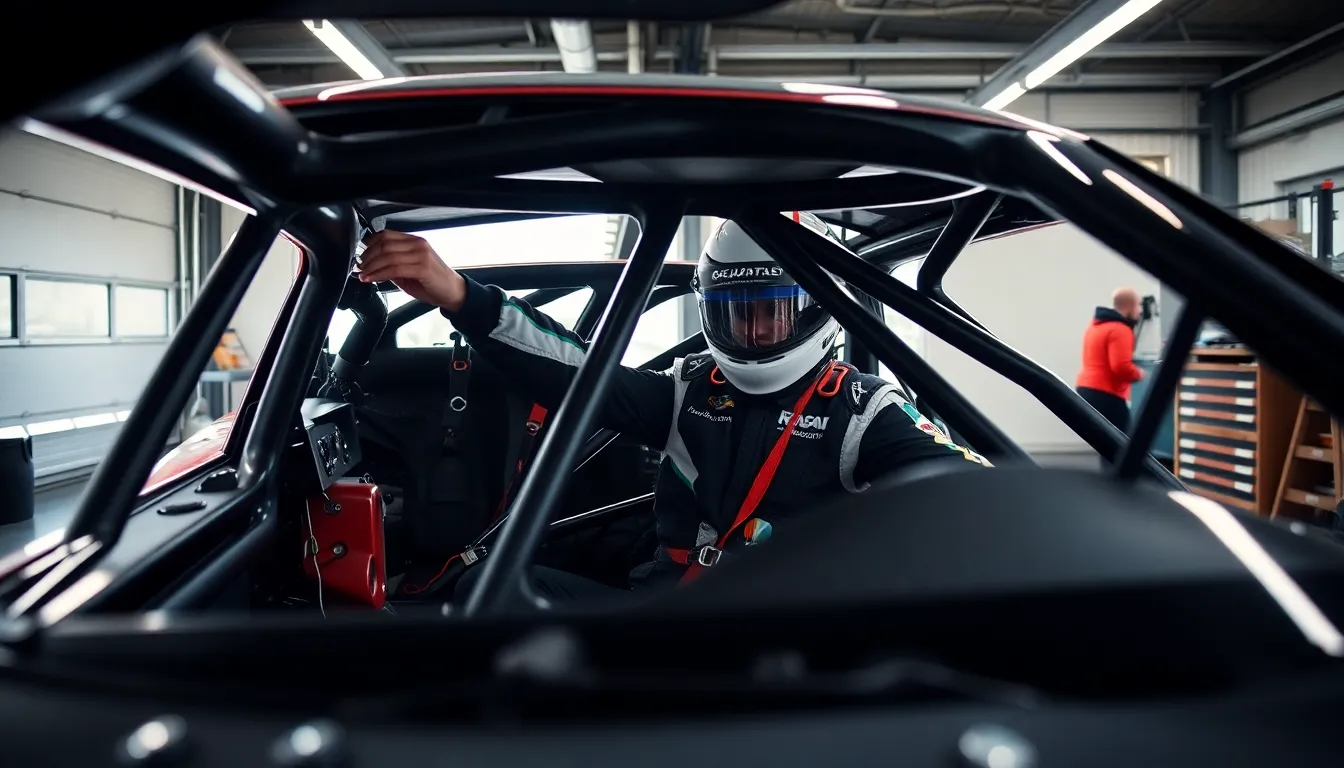
Professional drift cars demand extensive safety modifications to protect drivers during high-speed sideways action. We’ll explore the essential safety systems that transform street cars into track-ready drift machines.
Roll Cage Installation
Multi-point roll cages serve as the primary safety foundation for any serious drift build. Professional Formula Drift regulations require 10-point chromoly steel roll cages that meet SFI 25.1 specifications. These structures distribute crash forces throughout the vehicle’s frame rather than concentrating impact energy on vulnerable areas.
Welded construction offers superior strength compared to bolt-in alternatives. Certified fabricators use DOM (Drawn Over Mandrel) tubing with wall thicknesses ranging from 0.083 to 0.120 inches depending on the vehicle’s weight class. Competition-spec cages typically cost between $3,000-$8,000 installed by professional shops.
Door bar configurations require careful planning to maintain driver accessibility. NASCAR-style door bars provide maximum side impact protection but can complicate entry and exit procedures during practice sessions. Many drift teams choose removable door sections that balance safety requirements with practical considerations.
Racing Seats and Harnesses
Fixed-back racing seats replace factory seating to provide enhanced lateral support during sustained drifts. FIA-approved seats like the Sparco Evo or Recaro Profi SPG feature deep side bolsters and integrated HANS device mounting points. These seats cost $800-$2,500 and must be replaced every five years according to competition regulations.
Six-point harness systems distribute crash loads across the driver’s torso and pelvis. Professional drifters prefer Schroth or Simpson harnesses with 3-inch shoulder straps and 2-inch lap belts. The anti-submarine belt prevents drivers from sliding under lap belts during frontal impacts.
Proper mounting angles ensure harness effectiveness during crashes. Shoulder straps should angle downward between 10-25 degrees from the driver’s shoulders to the mounting point. Harness mounting plates welded to the roll cage provide stronger attachment points than factory seat belt mounting locations.
Fire Suppression Systems
Onboard fire suppression systems activate automatically during impacts or can be triggered manually. AFFF (Aqueous Film Forming Foam) systems like the Lifeline Zero 2000 distribute suppressant throughout the cockpit and engine bay within seconds. Professional drift cars typically use 4-liter systems costing $1,200-$2,000.
Nozzle placement requires strategic positioning to cover critical fire zones. Engine bay nozzles target fuel lines and electrical components while cockpit nozzles protect the driver compartment. External activation switches allow corner workers to deploy the system if the driver becomes unconscious.
Pull cable systems provide backup activation methods for drivers wearing gloves. Bright red activation handles mounted within easy reach enable quick deployment during emergencies. Annual system inspections ensure proper pressure levels and verify that discharge nozzles remain unobstructed by modifications.
Maintenance Tips for Drift Cars
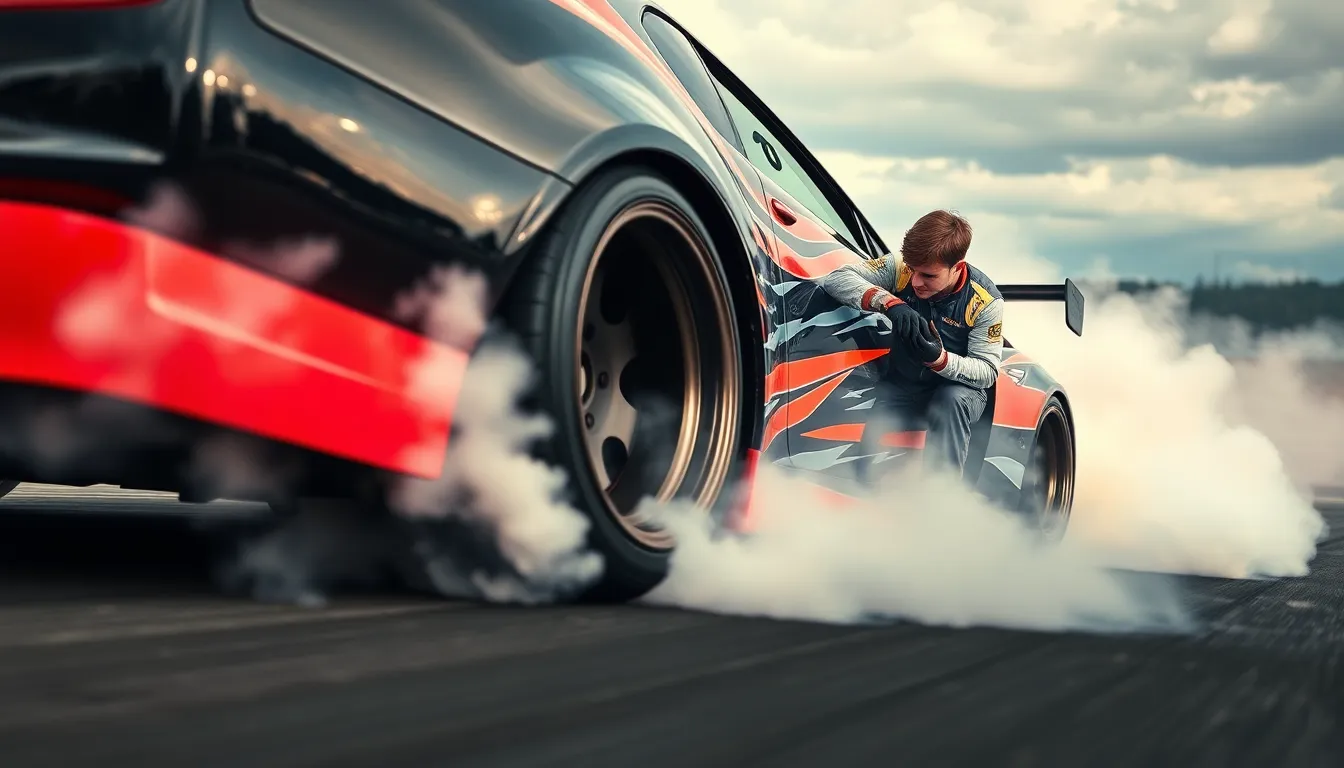
Drift cars endure extreme stress during sideways action, making proper maintenance crucial for both performance and safety. Regular upkeep prevents costly failures and keeps your drift machine running at peak performance.
Tire Replacement Schedules
Tires represent the most frequently replaced component on any drift car, with consumption rates far exceeding normal driving conditions. Professional drifters typically burn through a set of rear tires every 2-3 practice sessions, while weekend warriors might expect 5-10 sessions depending on driving style and track conditions.
We recommend keeping detailed logs of tire usage to predict replacement needs accurately. Most drift tires show visible wear indicators when the tread depth reaches 4/32″, signaling time for replacement before complete degradation occurs.
Front tires generally last 3-4 times longer than rears since they primarily handle steering duties rather than power delivery. Budget conscious drifters often rotate partially worn rear tires to the front position to maximize tire life while maintaining grip for steering precision.
Quality drift tires like Falken RT615K+ or Nitto NT05 cost between $150-250 per tire, making tire budget planning essential for regular track attendance. Professional teams spend $15,000-30,000 annually on tires alone, highlighting the important ongoing expense of competitive drifting.
Brake System Upgrades
Brake systems face tremendous heat and stress during drift sessions, particularly when drivers use techniques like handbrake initiations and trail braking. Standard brake pads typically fade after 15-20 minutes of aggressive drifting, necessitating immediate upgrades for serious practitioners.
Performance brake pads such as Hawk HP+ or EBC Yellowstuff provide superior heat resistance and consistent bite under extreme conditions. These pads cost $80-150 per axle but deliver predictable performance throughout extended sessions.
Stainless steel brake lines eliminate the spongy pedal feel common with rubber lines under high temperatures. We’ve found that upgrading to steel lines costs approximately $100-200 but provides noticeably improved pedal response and consistency.
Brake fluid replacement becomes critical every 3-6 months for active drift cars due to moisture absorption and thermal breakdown. High temperature fluids like Castrol SRF or Motul RBF 660 withstand track temperatures exceeding 500°F, preventing dangerous brake fade during competition.
Big brake kits from companies like Brembo or Wilwood offer the ultimate stopping power for high horsepower drift builds. These systems range from $2,000-5,000 but provide unmatched performance and reliability for professional level competition.
Engine Cooling Answers
Drift cars generate excessive heat from sustained high RPM operation and the additional stress of maintaining sideways momentum. Standard cooling systems often prove inadequate for track use, leading to overheating and potential engine damage.
Aluminum radiators offer 25-30% better heat dissipation compared to stock units while reducing weight by 10-15 pounds. Quality aftermarket radiators from Mishimoto or CSF cost $300-600 but provide essential thermal management for modified engines.
Electric cooling fans deliver superior airflow compared to mechanical units, especially during low speed drift sections where natural airflow decreases. Dual electric fan setups draw 2,500-3,500 CFM while reducing parasitic power loss by 10-15 horsepower.
Oil coolers become mandatory for turbocharged drift builds producing over 400 horsepower, as oil temperatures can exceed 280°F during extended sessions. Setrab or Mocal oil coolers ranging from $200-500 maintain oil temperatures below 220°F for optimal engine protection.
We strongly recommend installing temperature gauges for both coolant and oil to monitor thermal conditions continuously. Digital gauge clusters from AEM or Innovate provide real time data, allowing drivers to adjust their driving style before reaching dangerous temperature thresholds.
Conclusion
Drift cars represent the perfect fusion of mechanical engineering and artistic expression. We’ve explored how these machines evolved from underground street racing into a sophisticated motorsport discipline that demands both technical knowledge and unwavering dedication.
Whether you’re drawn to legendary Japanese platforms or considering American muscle and European alternatives the path into drifting offers something for every budget and skill level. The key lies in understanding that success isn’t measured purely by horsepower numbers but by the harmony between driver chassis and conditions.
As drift culture continues expanding globally we’re witnessing unprecedented innovation in both grassroots builds and professional competition machines. The community’s emphasis on safety development and shared knowledge ensures this thrilling motorsport will continue attracting new generations of enthusiasts who appreciate the art of controlled chaos.
Frequently Asked Questions
What makes a car good for drifting?
A good drift car needs rear-wheel drive (RWD) for controlled oversteer, balanced weight distribution (ideally 50/50), and a manual transmission for precise power control. These features allow drivers to maintain sustained sideways motion while having full control over the vehicle’s drift angle and power delivery.
Which Japanese cars are best for beginners in drifting?
The Toyota AE86 Corolla is considered the ultimate beginner drift car due to its lightweight design and predictable handling. The Nissan 240SX is also excellent for newcomers, offering affordability and strong drift potential. Both cars are forgiving for learning drift techniques.
Can American muscle cars be used for drifting?
Yes, modern American muscle cars like the Ford Mustang S550, Chevrolet Camaro, and Dodge Challenger have become popular drift platforms. They offer powerful engines and sophisticated chassis designs, though they may require specific modifications like suspension upgrades and weight reduction for optimal drift performance.
What are the most important modifications for a drift car?
Essential modifications include coilover suspension systems for adjustable handling, angle kits to increase steering lock, limited slip differentials for maintaining drift angles, and engine upgrades for increased power. Safety equipment like roll cages and racing seats are also crucial modifications.
How much does it cost to build a drift car?
Budget drift builds can start from $3,000-$8,000 for cars like the Nissan 240SX or BMW E30, plus modification costs. Professional Formula Drift cars can cost upwards of $150,000 to build, producing 700-1,200 horsepower with advanced technology and custom components.
What safety equipment is required for drift cars?
Essential safety equipment includes multi-point roll cages for driver protection, racing seats with proper harnesses for support during high-speed maneuvers, and onboard fire suppression systems. These modifications are crucial for transforming street cars into safe, track-ready drift machines.
How often do drift cars need maintenance?
Drift cars require frequent maintenance due to extreme stress on components. Tires need regular replacement as they wear quickly, brake systems require performance upgrades and frequent inspection, and enhanced cooling systems are essential to manage the heat generated during intense drift sessions.
Are European cars good for drifting?
Yes, European cars like the BMW E30 and E36 models are excellent drift platforms, known for exceptional balance and predictable handling. The Mercedes-Benz W124 and even the Volvo 240 have gained popularity as unique, capable drift alternatives in the European drift scene.

